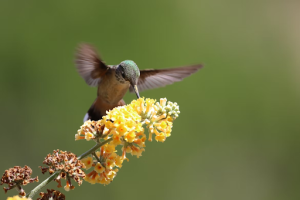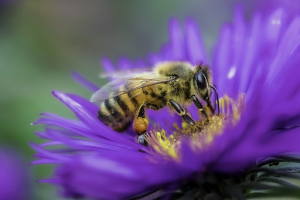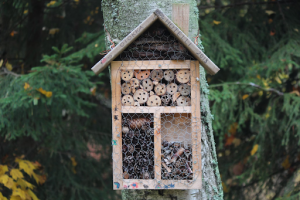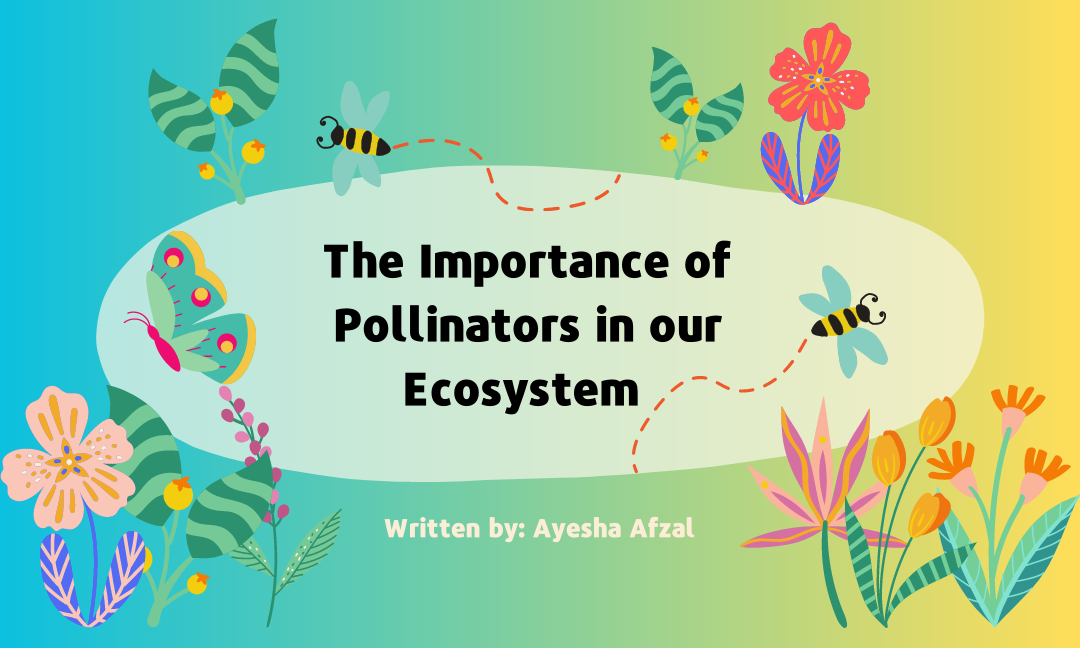Written by: Ayesha
Edited by: Cece Ndiwa
Designed by: Ayesha
Published by: Maryam Khan
The Importance of Pollinators in our Ecosystem

What are pollinators?
Pollinators are bees, flies, wasps, beetles and even some birds! Pollinators carry pollen from one plant to another, a process essential for plant reproduction. Most of the pollen transferred by insects and hummingbirds is done so unknowingly. The particles of pollen stick to their bodies and get carried and dropped off to a different place creating harmony within the ecosystem. It is said that almost one third of the food we eat is directly connected to the presence of pollinators in our environment. Pollinators not only support the ecosystem by the process of pollination, but also stabilize soils for healthier plant growth and support wildlife.
What would happen if pollinators such as bees became extinct?
Bees and other pollinators are endangered and are at a high risk of declining in numbers which could have a huge negative impact on the environment and the ecosystem. If pollinators were to go extinct, it would really cease the production of crops, fruit and vegetables. A study from Cornell University shows that “14 billion dollars worth of seeds in crops in the United States alone, is pollinated by bees.” It is a similar case for other parts of the world including Canada. There are a lot of consequences that go with the extinction of pollinators. This undoubtedly implies that we need to protect the pollinators as they are keeping a stabilized and ongoing ecosystem.

What are some factors that are causing the decline of pollinators?
There are a few factors negatively affecting the pollinator population.
1.The decreasing wild plants and loss of habitat:
Like many other endangered animals, pollinators are missing a proper habitat and finding less wildflowers to feed from. Commercialization and lawn mowing could be two causes for the decrease. Pollinators are not able to find enough food from these flowers causing them to weaken. Weakened bees, wasps and other pollinators are prone to disease from pesticides and other chemicals. Pollinators completely depend on the nectar found in flowers for nutrition and large cities, population and the loss of natural habitat and plant diversity is negatively impacting the pollinators or our ecosystem.
2.Pesticides:
This is something that causes a major disruption to the environment’s pollinators. Man made chemicals are extremely harmful to bees, wasps and birds. The residue of insecticides, pesticides and other chemicals is left on the petals of flowers, in the nectar inside of those flowers or in pollen. This kills or damages the pollinators’ ability to raise their young, successfully spread pollen or to even get back to their hive. Consequently, if a bee returns to its hive carrying the chemical, it can spread disease to the other bees causing major harm to the entire hive.

How can we help preserve pollinators?
Here are a few ways to protect the pollinator population.

1.Gardening and Native Plants:
We can grow native plants in a backyard or outdoor space. This is helpful to maintain a healthy local environment and provide nutritious food for the pollinators.
2. Bee Nesting Places:
Whether you DIY or get a wooden bee nest, you can provide them with a place to raise their young. Make sure to have pollinator friendly plants nearby to ensure that the bees are able to get enough food.
3. Avoid Pesticides:
Chemicals like pesticides are extremely harmful to pollinators so it is best to find organic methods to maintain a pest free garden safe for the pollinators as well as the environment
These are only some of the ways we can contribute to protecting pollinators. It is essential to spread awareness and talk about the role of pollinators in our environment and how they play a vital role in keeping the natural ecosystem stabilized.
Works Cited
What are the Consequences? . Endangered Bees . (n.d.). Retrieved April 4, 2023, from https://depts.washington.edu/triolive/quest/2007/TTQ07077/consequences.html
10 ways to save Pollinators • The National Wildlife Federation Blog. The National Wildlife Federation Blog. (2022, April 4). Retrieved April 4, 2023, from https://blog.nwf.org/2021/06/10-ways-to-save-pollinators/
Protecting pollinators. Xerces Society. (n.d.). Retrieved April 4, 2023, from https://www.xerces.org/protecting-pollinators#:~:text=The%20pollinator%20protection%20pledge%20is,possible%20to%20implement%20anywhere%2C%20anytime!
David Smitley, M. S. U. E. D. B. (2022, January 21). Factors that threaten Pollinator Health. Pollinators & Pollination. Retrieved April 4, 2023, from https://www.canr.msu.edu/news/factors-that-threaten-pollinator-health#:~:text=Most%20 researchers%20 agree%20that%20 a,pesticide%20 exposure%2C%20 parasites%20and%20 pathogens.
U.S. Department of the Interior. (n.d.). What is a pollinator? National Parks Service. Retrieved April 4, 2023, from https://www.nps.gov/subjects/pollinators/what-is-a-pollinator.htm
Republic of Slovenia Ministry of Agriculture, Forestry and Food . (n.d.). The importance of bees and other pollinators for food and agriculture . Food and Agriculture Organization of the United Nations. Retrieved April 5, 2023, from https://www.fao.org/3/i9527en/i9527en.pdf
Terpstra, J. (2017, September 25). Meet Ontario’s pollinators. Meet Ontario’s Pollinators | Ontario Agricultural College. Retrieved April 4, 2023, from https://www.uoguelph.ca/oac/news/meet-ontarios-pollinators#:~:text=Bees%2C%20butterflies%20and%20wasps%2C%20oh%20my!&text=Sure%2C%20the%20honey%20bee%20is,beetles%2C%20bats%20and%20humming%20birds.
Picture Sources:
Christoph Polatzky on Unsplash
John Duncan on Unsplash
Tania Malréchauffé on Unsplash
Dustin Humes on Unsplash

